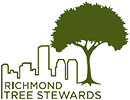English ivy, Hedera helix, is a threat to trees but it is a greater threat to the local ecosystem. This plant, in addition to other non-native, invasive species, is significant problem in our parks and natural areas in all parts of Richmond.

In natural areas English ivy covers the ground and becomes a monoculture replacing smaller native plants. Other plants cannot reproduce in these ivy deserts; new trees or shrubs are unlikely to survive and natural succession is disrupted. Native plants that provide food and cover for wildlife will diminish over time, fewer animal species are supported and the once complex ecosystem unravels. Though some of our beautiful song birds feed on ivy berries, they need insects to raise their young and these are provided in sufficient numbers only with a variety of native plants. Imagine your favorite park as a sea of ivy without native trees such as redbud, flowers, few birds, few butterflies, and only the remnants of large old trees burdened by ivy.
When ivy encounters a vertical surface, small “rootlets” sprout from the leaf node and attach to the tree, wall , post, etc. The vine does not strangle the tree and the roots do not penetrate the bark, but the ivy does compete with the tree for water and nutrients, and heavy infestations weaken a tree. Large amounts of ivy on the tree adds weight making large branches or the entire tree more likely to to fall during wind events. Snow or ice are even more hazardous because accumulation on the evergreen leaves adds more weight to the tree, making failure more likely.
![CropperCapture[145]](https://richmondtreestewards.files.wordpress.com/2010/11/croppercapture145.jpg?w=289&h=300) The Ivy Cycle
The Ivy Cycle
English ivy has two distinct phases – juvenile and adult. The juvenile form grows on the ground; as long growth continues horizontally the plant stays in this form. The adult form which will produce flower, fruit, and seed occurs only after the plant has grown up some vertical surface, which is often a tree. At this point the vine “uses” the tree to complete its life cycle, and birds will eat the fruit and then spread the seed to other locations.
 1. Juvenile vine 2. Mature form with flowers 3. Fruit
1. Juvenile vine 2. Mature form with flowers 3. Fruit
-
Photo credit 1: Chuck Bargeton / Bugwood.org
-
Photo credit 2&3: Forest and Kim Starr / Bugwood.org
